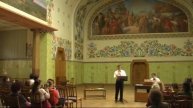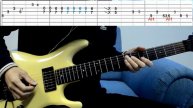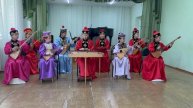Orchestral Suite No. 3 (1883) IV. Tema con variazioni - Tchaikovsky, Op 55
Full Playlist:
https://www.youtube.com/playlist?list=PLehSPRsBkJ8HzWbUEtr7Qq4vA8I7tWiuR
Sir Neville Marriner
Radio-Sinfonieorchester Stuttgart
violin Hans Kalafusz
Movements and Duration:
There are four movements, and a complete performance lasts around 40 to 45 minutes.
The fourth, a theme and variations, are longer than the other three movements combined.
No.1.Élégie
https://youtu.be/PJrFgX4uayE
Andantino molto cantabile (G major)
No.2.Valse mélancolique
https://youtu.be/OymgJZSLOSc
Allegro moderato (E minor)
No.3.Scherzo
https://youtu.be/J8MmzqlNDcY
Presto (E minor)
No.4.Tema con variazioni
https://youtu.be/8D8IetdB304
Andante con moto (G major)
1. Andante con moto, 2/4
2. Andante con moto, 2/4
3. Andante con moto, 2/4
4. Pochissimo meno animato, B minor
5. Allegro vivo, 3/4, G major
6. Allegro vivace, 6/8, G major
7. L'istesso tempo, 2/4, G major
8. Adagio, 3/4, A minor (closing in E major)
9. Allegro molto vivace, 2/4, A major
10. Allegro vivo e un poco rubato, 3/8, B minor
11. Moderato mosso, 4/4, B major
12. Finale. Polacca-Moderato maestoso e brillante, 3/4, G major
Tchaikovsky
(1884)
Orchestral Suite No. 3
in G, Op. 55
It was written and orchestrated between April and July 1884. It is the longest and best known of his four orchestral suites.
Instrumentation:
The Suite is scored for an orchestra of 3 flutes (3rd doubling piccolo), 2 oboes, English horn, 2 clarinets (in A), 2 bassoons + 4 horns (in F), 2 trumpets (in D, F), 3 trombones, tuba + 3 timpani, military drum, tambourine, triangle, cymbals, bass drum + harp, violins I, violins II, violas, cellos, and double basses.
Movements and Duration:
There are four movements and a complete performance lasts around 40 to 45 minutes. The fourth a theme and variations longer than the other three movements combined.
Composition:
Following the production of the opera Mazepa in Moscow in February 1884, Tchaikovsky went abroad. While staying in Paris, he wrote to Praskovya Tchaikovskaya on 23 February/6 March 1884: "I'm still not feeling wholly myself due to exhaustion, and I think that without the peace and tranquillity of the countryside I shall not be able to do any work, but at the moment I feel the urge to start something new".
It would be some time before the composer settled on the form that the new work should take, and his thoughts ranged from a projected symphony, to a piano concerto, and then to a suite. Thus, on 23 February/6 March he told Modest Tchaikovsky: "I think that in Kamenka I will be engaged in writing a symphony".
Arriving at Kamenka around 12/24 April, the composer began sketching in rough some ideas for the future symphonic work. Surviving diary entries, letters and sketches in one of his note books from this period provide a complete record of the process of composition.
Arrangements:
Tchaikovsky arranged the Suite for piano duet (4 hands) before he began the orchestration, starting on 25 May/6 June with the variations. By 7/19 June this work was complete.
Publication:
In letters of 1/13 August to Modest Tchaikovsky and to Nadezhda von Meck, Tchaikovsky reported that the Suite was already being engraved. From the early/mid September up to December 1884, Tchaikovsky was occupied with checking the proofs of the Suite.
The orchestral parts and full score of the Suite No. 3 were published by Pyotr Jurgenson in January 1885; the arrangement for piano duet was issued by the same publisher in February that year. For copyright reasons the same editions, but with different covers and imprints, were simultaneously issued by Bote & Bock in Berlin.
Autographs:
Tchaikovsky's autograph full score is now preserved in the Russian National Museum of Music in Moscow (ф. 88, No. 77), except for the pages containing variations VII to IX in the Finale, which are held at the Klin House-Museum Archive (a1, No. 297).
The original manuscript of Tchaikovsky's arrangement of the Suite for piano duet is also preserved in the Russian National Museum of Music in Moscow (ф. 88, No. 78).
Dedication:
The Suite is dedicated to the German conductor Max Erdmannsdörfer, to make amends for the composer's absence when Erdmannsdörfer conducted the premiere of the Second Suite in February 1884.
Related Works:
The themes of the abandoned first movement — Contrastes — were re-used in the second movement of the Concert Fantasia (1884).
The central section of the fourth variation in the finale quotes from the plainsong tune "Dies Irae".
Видео Orchestral Suite No. 3 (1883) IV. Tema con variazioni - Tchaikovsky, Op 55 автора Нотный парад
Видео Orchestral Suite No. 3 (1883) IV. Tema con variazioni - Tchaikovsky, Op 55 автора Нотный парад
Информация
16 апреля 2024 г. 15:49:01
00:18:43
Похожие видео
![Jean Beauvoir - Feel The Heat (From Cobra [1986])](http://pic.rutubelist.ru/video/2025-04-29/97/33/97336bdca4906270c2f37ece9cf92769.jpg?size=s) Jean Beauvoir - Feel The Heat (From Cobra [1986])
Jean Beauvoir - Feel The Heat (From Cobra [1986]) песня Утомленое солнце. Леонид Утесов. х-ф Чаклун и Румба 2007г
песня Утомленое солнце. Леонид Утесов. х-ф Чаклун и Румба 2007г Полтава Олег авторское.avi
Полтава Олег авторское.avi Vivaldi - Concert/ Albinoni- Adagio, 24.02.2022
Vivaldi - Concert/ Albinoni- Adagio, 24.02.2022 Поймай момент, не отпускай его! 🛹🚀🔥"
#драйв #скейтвкайф #созданиеконтента #реилссвибрацией
Поймай момент, не отпускай его! 🛹🚀🔥"
#драйв #скейтвкайф #созданиеконтента #реилссвибрацией Kaoma Lambada Violin Cover
Kaoma Lambada Violin Cover ДИСКО ДЭНС пати!!! Песни под которые хочется петь и танцевать
ДИСКО ДЭНС пати!!! Песни под которые хочется петь и танцевать Алексеевский марш. heavy metal. symphony orchestra. male vocals.
Алексеевский марш. heavy metal. symphony orchestra. male vocals. Песня Просто Бомба- "Странная ДУЭЛЬ"
Песня Просто Бомба- "Странная ДУЭЛЬ"![Unlock in
[Shorts]](http://pic.rutubelist.ru/video/2025-04-29/40/3d/403d307eb30262ef88636091028a04f8.jpg?size=s) Unlock in
[Shorts]
Unlock in
[Shorts] How to play #5/5 Surfing with the Alien - Joe Satriani - beat-based Tab played with Metronome
How to play #5/5 Surfing with the Alien - Joe Satriani - beat-based Tab played with Metronome USED/Enya EUT-MAD w/PU Tenor@ukuleleshoptantan
USED/Enya EUT-MAD w/PU Tenor@ukuleleshoptantan Пустой взгляд - Безгранично
Пустой взгляд - Безгранично "В лунном сиянии" cover Евгения Смольянинова
"В лунном сиянии" cover Евгения Смольянинова АМУРУГЛЕПРОФ
АМУРУГЛЕПРОФ ансамбль "Байрчик"
МБУ ДО "Детская школа искусств №2", г.Элиста
ансамбль "Байрчик"
МБУ ДО "Детская школа искусств №2", г.Элиста poymelissa – Холодное тело
poymelissa – Холодное тело God Rest Ye Merry Gentlemen
God Rest Ye Merry Gentlemen Schnittke : Sonata for violin and piano No.1 Mov.I
Schnittke : Sonata for violin and piano No.1 Mov.I La Ritirata - Allegro from Vivaldi's Concerto in G minor RV105
La Ritirata - Allegro from Vivaldi's Concerto in G minor RV105
